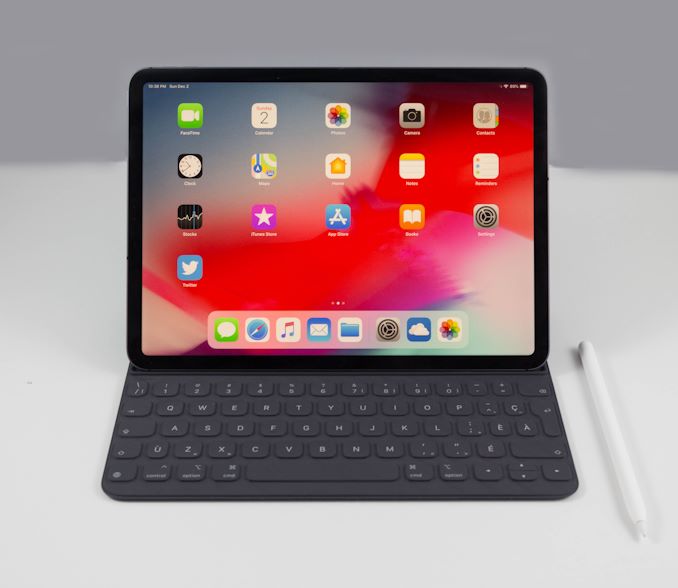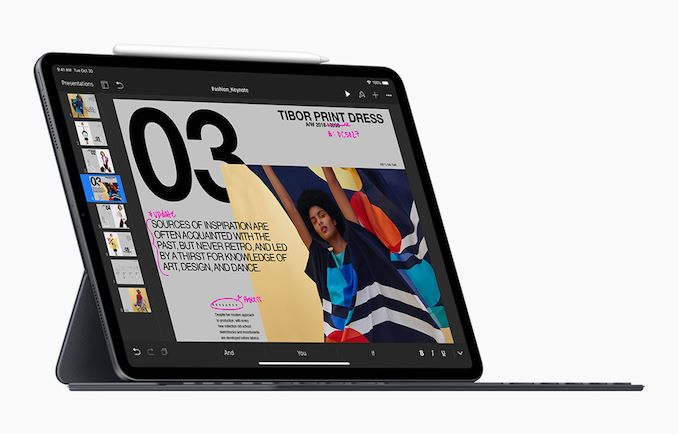The 2018 Apple iPad Pro (11-Inch) Review: Doubling Down On Performance
by Brett Howse & Andrei Frumusanu on December 4, 2018 10:00 AM EST
I think it’s safe to say that in 2018, the tablet market has not shaped up like anyone had expected, not even Apple. Tablets weren’t the next smartphone – and indeed the sales of dedicated tablets are downright soft – and yet at the same time tablets have successfully carved out a meaningful niche for themselves. But more importantly still, the tablet concept is everywhere even if “pure” tablets themselves aren’t. One needs only look at all the various PC 2-in-1s and convertibles to see the influence tablets have made on the traditional laptop market, forcing these many clamshells into becoming something more.
As a consequence of the introduction of modern tablets and their subsequent efforts to secure their own place in the market, we’ve essentially seen the tablet and tablet-alike market bifurcate into two real clusters of tablet designs. On the one hand are the cheap content consumption devices – the iPads, Fire TVs, and myriad of cheap Android tablets. On the other hand is the far more exclusive market for high-end, productivity-oriented tablets; devices that don’t just consume content, but create it as well. This market has been slower to develop, but it’s also important for its own reasons, as it’s the real crossover point between tablets as envisioned by the iPad, and the traditional PC laptop market.
Apple for their part has opted to go after both of these markets, and has done so successfully. The traditional 9.7-inch iPad needs no introduction, and while the iPad Pro is a little less known, the difference isn’t by much. Built upon the shoulders of the original iPad, the iPad Pro family takes things one step further, building towards not just a bigger and better iPad, but by giving the tablet the features that are needed for productivity and content creation, at both a hardware and a software level. The iPad Pro doesn’t try to be a traditional laptop, but it certainly tries to capture a lot of their usefulness, and this is especially the case for the 2018 iPad Pro.
With the introduction of the latest iPad Pro models, Apple’s iPad lineup for 2018 offers arguably the largest design change since the original iPad launched. The new design offers a much higher screen-to-body ratio than ever offered before, mimicking what they’ve done with the iPhone lineup. As a result, Apple has more or less reinvented the iPad Pro design, and offers plenty of new features inside and out.
Apple’s ambitions with the iPad Pro start with their chip design team, which has created the Apple A12X System on a Chip to power the latest iPad Pro. As outlined in our iPhone XS review, the A12 series of SoCs are already well ahead of the ARM competition, and Apple clearly has its sights on the performance levels of x86 CPUs from Intel. A12X features four Apple Vortex CPU cores, double that of the regular A12 in the iPhone, and seven A12 GPU cores which Apple says provides the power of an Xbox One S in a device with a far smaller power budget.
For better or worse, the iPad Pro is attached at the hip with Apple’s mobile operating system iOS, and unsurprisingly the iPad Pro ships with the latest version, iOS 12.1.
Apple’s iPad Pro lineup has also been their test bed for their newest display technology, and the iPad Pro keeps the 120 Hz ProMotion display, which offers variable refresh rate down to 24 Hz, along with P3 display gamut coverage tied in with their color managed software. Apple also keeps their True Tone option to dynamically adjust the white balance of the display to match the lighting conditions of the room it’s in.
|
Apple iPad Pro Comparison |
||
| iPad Pro 11-Inch (2018) |
iPad Pro 12.9-Inch (2018) |
|
| SoC | Apple A12X 4x Apple Vortex 4x Apple Tempest 7 core A12 GPU |
|
| Display | 11-inch 2388x1668 IPS LCD P3 D65, 120Hz |
12.9-inch 2732x2048 IPS LCD P3 D65, 120Hz |
| Dimensions | 247.6 x 178.5 x 5.9 mm 468 / 468 grams (WiFi / LTE) |
280 x 214.9 x 5.9 mm 631 / 633 grams (WiFi / LTE) |
| RAM | 4 GB (up to 512 GB Storage) 6 GB (1 TB model) |
|
| NAND | 64GB / 256GB / 512GB / 1TB | |
| Battery | 29.37 Wh | 36.71 Wh |
| Front Camera | 7MP, f/2.2, Smart HDR, Wide Color Gamut, Retina Flash | |
| Rear Camera | 12MP, f/1.8, PDAF, Smart HDR, Wide Color Gamut, True Tone Quad-LED flash |
|
| Cellular | 2G / 3G / 4G LTE (Category 16) Intel XMM 7560 Modem |
|
| SIM Size | NanoSIM | |
| Wireless | 802.11a/b/g/n/ac 2x2 MIMO, BT 5.0, GPS/GLONASS | |
| Connectivity | USB-C Apple Smart Connector |
|
| Launch OS | iOS 12.1 | |
| Launch Price | Wi-Fi: $799 (64GB) $949 (256GB) $1149 (512GB) $1549 (1TB) Wi-Fi + LTE: $949 (64GB) $1099 (256GB) $1299 (512GB) $1699 (1TB) |
Wi-Fi: $999 (64GB) $1149 (256GB) $1349 (512GB) $1749 (1TB) Wi-Fi + LTE: $1149 (64GB) $1299 (256GB) $1499 (512GB) $1899 (1TB) |
Apple has also taken the opportunity to switch the iPad Pro lineup over from their proprietary Lighting connector to the more ubiquitous USB-C port, making this the first iOS device to offer USB connectivity. Where they give, they also take away though, and the 3.5 mm headset jack has gone the way of the Dodo, and for more or less the same reasons.
For those that want to work on the go, Apple continues its excellent tradition of offering cellular connectivity with the iPad Pro, and those that need a lot of storage will be happy to see models up to 1 TB, which is more important because the iPad offers no way to access external storage to increase this.
What first set the iPad Pro apart from the rest of the iPad lineup was the ability to use the Apple Pencil as well as a first-party keyboard solution. For the 2018 iPad Pro, both of these accessories have gotten refreshes as well.
The iPad Pro for 2018 is a major change from the outgoing models. Let’s dig in and see how it fares.











145 Comments
View All Comments
thunng8 - Wednesday, December 5, 2018 - link
Yes, way ahead of Core M, especially for graphics. Something like 5-6X faster in gfxbench.Brett Howse - Wednesday, December 5, 2018 - link
There's a few results in there already from the MacBook Air with Y Series.name99 - Wednesday, December 5, 2018 - link
The most interesting thing, to me, is the cache topology.While everyone else at the high end has been retreating to private L2 caches, and a large shared L3, Apple has doubled down on a
- LARGE L2 that's
- shared by at least 4 clients
with L3 acting more as the communications/sharing space between different blocks like CPU, GPU, ISP, NPU.
Clearly it's working for them! It also suggests that when they scale even larger (the inevitable ARM Macs and [internal use] servers) they'll likely ship something that looks very different from not just Intel's high end (private L2, distributed L3 slice per core) but perhaps also the current ARM servers?
Do we know anything at all about the NoC that's in use on Apple SoCs, and, second best, on other ARM SoCs (eg QC, Samsung)? A ring? A crossbar? Point to point with direct links from each block to L3, but no block-to-block communication?
Railgun - Wednesday, December 5, 2018 - link
These reviews lately are killing me. Zero consistency from chart to chart. Why in one metric are we comparing a tablet to phones, and others to other tablets...and nada against its predecessor? There are so many reviews like this.Brett Howse - Wednesday, December 5, 2018 - link
Some of the tests are mobile only.Some of the tests are not.
This device bridges both so why would we not compare it to both?
Socius - Wednesday, December 5, 2018 - link
Charging time with a proper adapter is insanely fast on the iPad pro. Using a 20,000mah battery pack, I was able to charge it up from 3% to 45% in about 30-35 minutes. That is absolutely incredible.Also, you can change the tip on the Apple Pencil as it is a simple screw off design. Apple itself doesn't sell different tips but I'm sure 3rd party would step in pretty soon.
One thing you didn't cover is the disk read/write performance. And it differs greatly based on which model iPad you get. The 12.9" 1TB WiFi model is substantially faster than other capacities. And the extra ram has helped keep apps/games in memory far longer than they would on my XS Max with its 4GB ram.
We'll be able to better compare the productivity performance of the iPad Pro once the full Photoshop CC port is released in 2019. But in the mean time, I'm editing through 4K videos using LumaFusion like it's nothing. This isn't a desktop. But with the right apps, it can come pretty close to being able to handle 90% of your workflow. In such a small and portable package. I find myself designing websites on it while sitting on the couch. The drag-and-drop feature between application windows in split view is such a big help as well.
Overall, I picked the iPad Pro over the Surface Pro due to the 120Hz display. And once Photoshop is ported over in a few months, I'll be able to do so much more of my work on it. I think my only gripe is that Microsoft Office is so weak on the iPad Pro. If only I had access to the full desktop version.
lilo777 - Wednesday, December 5, 2018 - link
1. Don't work on your couch.2. iPad does not have 120Hz display
darklight69 - Thursday, December 6, 2018 - link
1. He/She can work wherever they feel like. What kind of control freak are you to demand otherwise from complete strangers.2. Yes it does, says so in the review's display section - https://www.anandtech.com/show/13661/the-2018-appl...
"In addition, Apple’s iPad Pro offers their ProMotion technology, which means it is a 120 Hz display, but one that supports variable refresh rates in order to lower the display's refresh rate for power management purposes."
WasHopingForAnHonestReview - Wednesday, December 5, 2018 - link
Nonsense. How much are you paid for this co?mmentSocius - Thursday, December 6, 2018 - link
Which part of what I said do you disagree with or find questionable?